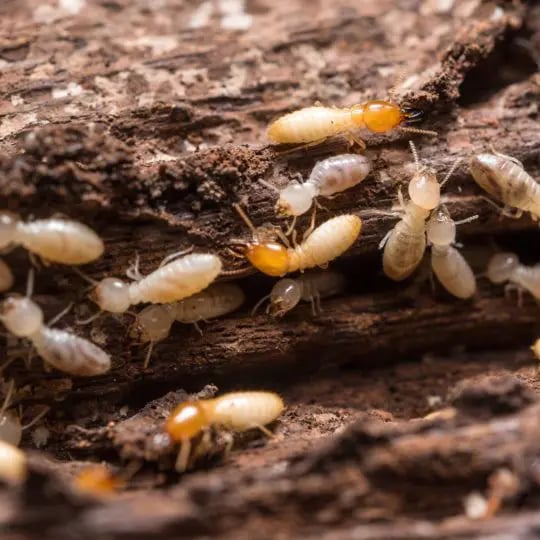
Scientific Name: Isoptera
Lifespan: Long – 2 years for workers, 10+ years for queens.
Problem: Property damage
Termites (classified as Isoptera, a subsection of the order Blattodea, to which cockroaches also belong) are advantageous for the environment in that they consume dead trees and wooden materials, and return vital nutrients to the soil to help plants to grow. They are also well-known for causing extensive and expensive damages to wood-built homes worldwide, hollowing them out and often causing crucial parts to collapse.
The Termite Life Cycle
- Eggs – Termite queens can lay up to 1,000 eggs per day in the center or “nursery” of the termite nest. They are white or yellowish, clear, very small and generally inaccessible to humans.
- Juveniles – Termite larvae molt within the nest multiple times before becoming pupae, at which point they will mature into one of four types of full-grown termites.
- Mature Bugs – Mature termites can take several forms. They can become either soldiers, termites with enlarged jaws that guard the nest from ants, workers, which forage, store food and feed juveniles, or “reproductives,” termites that grow wings, locate new nesting sites, and eventually become queens and kings.
Termite Habitats and Habits
Termites build their nests anywhere that they have access to soil, mud, and rotting wood, as these are the substances their nests are primarily made from. Near forested areas, they are very common. The nests may be located underground, within rotting wood, attached to living trees or extending upwards from the ground in structures referred to as “termite mounds.”
The termite diet consists almost exclusively of wood, but can also include decomposing leaves and even their own excrement. The workers create tunnels made from mud that extend from their nest to their food sources.
How to Recognize and Get Rid of Termite Infestations
The following signs indicate that you may have a termite infestation:
- Hollowed walls or beams
- Collapsing wooden structures
- Presence of swarming termites
- Discarded wings from termite swarms
- Mud tunnels about the width of a pencil near foundations
Termite Control
Controlling an active termite infestation can be very difficult and often requires professional assistance. A thorough termite inspection performed by an experienced exterminator will likely be necessary to determine the extent of the infestation.
Termite damage may also need to be repaired. Termites should be dealt with immediately, because the longer they survive the more damage they do. The good news is that effective termite treatments are available, and they can stop an infestation and prevent the pests from coming back.
Green Pest Solutions: Effective Termite Control in Pennsylvania, New Jersey and Delaware
Green Pest Solutions provides a wide range of affordable termite services that can keep these relentless pests from destroying your home. Contact us to schedule a free in-home termite inspection today!
Need Help with Termite Information | Get Rid of Termites in PA, NJ, DE?
Call today at and let's talk about how we can help you with Termite Information | Get Rid of Termites in PA, NJ, DE and other Pest Library.